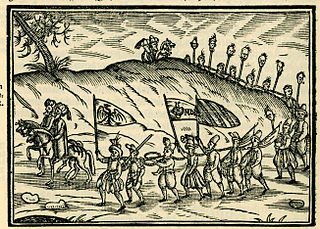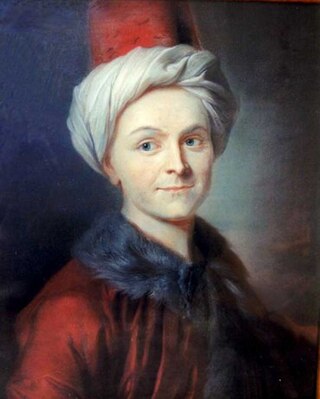Gallery
The Rålamb Costume Book contains drawings of signing dilsiz, "deaf-mutes". [3]
| Ottoman Sign Language | |
|---|---|
| Seraglio Sign Language | |
| Harem Sign Language | |
| Native to | Turkey |
| Region | Istanbul |
| Era | 15th to early 20th century |
| Language codes | |
| ISO 639-3 | None (mis) |
| Glottolog | None |
Ottoman Sign Language, also known as Seraglio Sign Language or Harem Sign Language, was a deaf sign language of the Ottoman court in Istanbul. Nothing is known of it directly, but it is reported that it could communicate ideas of any complexity, and that it was passed on to the young through fables, histories, and scripture.
During the reign of Suleiman the Magnificent, two deaf brothers were brought to the court. During this time, keeping disabled people at royal courts as oddities or pets was a fairly common practice (see court dwarf). These brothers were originally brought to court as such. They knew a sign language, likely a home sign of their own invention. Out of this, the practice was born. [1]
In 16th and 17th centuries, deaf pages, doormen, executioners, and companions of the sultan were valued for their ability to communicate silently, for their inability to overhear sensitive information at secret negotiations, and for the difficulty outsiders had in communicating with them or bribing them. At court, silence was at a premium, and several sultans preferred that sign language be used in their presence; they were able to jest with them in a way that would be inappropriately familiar in Turkish. Osman II (r. 1618–1622) was perhaps the first sultan to learn to sign, and ordered many of the hearing of his court to follow his lead. At their height, there may have been over a hundred deaf courtiers at any one time; it was considered undignified for the sultan to address his subjects orally, and also unseemly for those before him either to speak aloud, disturbing him, or to whisper secretly.
It is not known whether Ottoman Sign Language was ancestral to modern Turkish Sign Language, as no signs were recorded. [2]
The Rålamb Costume Book contains drawings of signing dilsiz, "deaf-mutes". [3]

Mehmed III was the sultan of the Ottoman Empire from 1595 until his death in 1603. Mehmed was known for ordering the execution of his brothers and leading the army in the Long Turkish War, during which the Ottoman army was victorious at the decisive Battle of Keresztes. This victory was however undermined by some military losses such as in Gyor and Nikopol. He also ordered the successful quelling of the Jelali rebellions. The sultan also communicated with the court of Elizabeth I on the grounds of stronger commercial relations and in the hopes of England to ally with the Ottomans against the Spanish.
Deaf-mute is a term which was used historically to identify a person who was either deaf and used sign language or both deaf and could not speak. The term continues to be used to refer to deaf people who cannot speak an oral language or have some degree of speaking ability, but choose not to speak because of the negative or unwanted attention atypical voices sometimes attract. Such people communicate using sign language. Some consider it to be a derogatory term if used outside its historical context; the preferred term today is simply deaf.

An odalisque was a chambermaid or a female attendant in a Turkish seraglio, particularly the court ladies in the household of the Ottoman sultan. In western European usage, the term came to mean the harem concubine, and refers to the eroticized artistic genre in which a woman is represented mostly or completely nude in a reclining position, often in the setting of a harem. It was part of a fascination with Orientalism, particularly in Great Britain and France.

A seraglio, serail, seray or saray is a castle, palace or government building which was considered to have particular administrative importance in various parts of the former Ottoman Empire.
The recorded history of sign language in Western societies starts in the 17th century, as a visual language or method of communication, although references to forms of communication using hand gestures date back as far as 5th century BC Greece. Sign language is composed of a system of conventional gestures, mimic, hand signs and finger spelling, plus the use of hand positions to represent the letters of the alphabet. Signs can also represent complete ideas or phrases, not only individual words.

The concept of Circassian beauty is an ethnic stereotype of the Circassian people. A fairly extensive literary history suggests that Circassian women were thought to be unusually beautiful and attractive, spirited, smart, and elegant. Therefore, they were seen as mentally and physically desirable for men, although most Circassians traditionally refused to marry non-Circassians in accordance with Adyghe Xabze. A smaller but similar literary history also exists for Circassian men, who were thought to be especially handsome.

The köçek was typically a very handsome young male slave effeminate dancer (rakkas), who usually cross-dressed in feminine attire, and was employed as an entertainer.

Harem refers to domestic spaces that are reserved for the women of the house in a Muslim family. A harem may house a man's wife or wives, their pre-pubescent male children, unmarried daughters, female domestic servants, and other unmarried female relatives. In the past, harems also enslaved concubines. In former times some harems were guarded by eunuchs who were allowed inside. The structure of the harem and the extent of monogamy or polygyny has varied depending on the family's personalities, socio-economic status, and local customs. Similar institutions have been common in other Mediterranean and Middle Eastern civilizations, especially among royal and upper-class families, and the term is sometimes used in other contexts. In traditional Persian residential architecture the women's quarters were known as andaruni, and in the Indian subcontinent as zenana.

Valide Sultan was the title held by the mother of a ruling sultan of the Ottoman Empire. The Ottomans first formally used the title in the 16th century as an epithet of Hafsa Sultan, mother of Sultan Suleyman I, superseding the previous epithets of Valide Hatun, mehd-i ulya. or "the nacre of the pearl of the sultanate".
Turkish Sign Language is the language used by the deaf community in Turkey. As with other sign languages, TİD has a unique grammar that is different from the oral languages used in the region.

The Kapi Agha, formally called the Agha of the Gate of Felicity, was the head of the eunuch servants of the Ottoman Seraglio until the late 16th century, when this post was taken over by the Kizlar Agha. In juxtaposition with the latter office, also known as the Chief Black Eunuch as its holders were drawn from Black African slaves, the Kapi Agha is also known as the Chief White Eunuch.

The Imperial Harem of the Ottoman Empire was the Ottoman sultan's harem – composed of the wives, servants, female relatives and the sultan's concubines – occupying a secluded portion (seraglio) of the Ottoman imperial household. This institution played an important social function within the Ottoman court, and wielded considerable political authority in Ottoman affairs, especially during the long period known as the Sultanate of Women.
Ottoman court was the culture that evolved around the court of the Ottoman Empire.

Turkish art refers to all works of visual art originating from the geographical area of what is present day Turkey since the arrival of the Turks in the Middle Ages. Turkey also was the home of much significant art produced by earlier cultures, including the Hittites, Ancient Greeks, and Byzantines. Ottoman art is therefore the dominant element of Turkish art before the 20th century, although the Seljuks and other earlier Turks also contributed. The 16th and 17th centuries are generally recognized as the finest period for art in the Ottoman Empire, much of it associated with the huge Imperial court. In particular the long reign of Suleiman the Magnificent from 1520 to 1566 brought a combination, rare in any ruling dynasty, of political and military success with strong encouragement of the arts.

In the Ottoman Empire, women enjoyed a diverse range of rights and were limited in diverse ways depending on the time period, as well as their religion and class. The empire, first as a Turkoman beylik, and then a multi-ethnic, multi-religious empire, was ruled in accordance to the qanun, the semi-secular body of law enacted by Ottoman sultans. Furthermore, the relevant religious scriptures of its many confessional communities played a major role in the legal system, for the majority of Ottoman women, these were the Quran and Hadith as interpreted by Islamic jurists, often termed sharia. Most Ottoman women were permitted to participate in the legal system, purchase and sell property, inherit and bequeath wealth, and participate in other financial activities, rights which were unusual in the rest of Europe until the 19th century.

Slavery in the Ottoman Empire was a major institution and a significant part of the Ottoman Empire's economy and traditional society. The main sources of slaves were wars and politically organized enslavement expeditions in the Caucasus, Eastern Europe, Southern Europe, Southeast Europe, and Africa. It has been reported that the selling price of slaves decreased after large military operations. In Constantinople, the administrative and political center of the Ottoman Empire, about a fifth of the 16th- and 17th-century population consisted of slaves. Statistics of these centuries suggest that Istanbul's additional slave imports from the Black Sea slave trade have totaled around 2.5 million from 1453 to 1700.

Enderûn was the term used in the Ottoman Empire to designate the "Interior Service" of the imperial court, concerned with the private service of the Ottoman sultans, as opposed to the state-administrative "Exterior Service" (Birûn). Its name derives from the location of the sultan's apartments in the inner courts of the Topkapi Palace; its head was the Kapi Agha.

Turquerie, or Turquoiserie, was the Turkish fashion in Western Europe from the 16th to 18th centuries for imitating aspects of Ottoman art and culture. Many different Western European countries were fascinated by the exotic and relatively unknown culture of the Ottoman ruling class, which was the center of the Ottoman Empire. This fashionable phenomenon became more popular through trading routes and increased diplomatic relationships between the Ottomans and the European nations, exemplified by the Franco-Ottoman alliance in 1715. Ambassadors and traders often returned home with tales of exotic places and souvenirs of their adventures.
Mahidevran Hatun also known as Gülbahar Hatun,, was a concubine of sultan Suleiman the Magnificent and the mother of Şehzade Mustafa of the Ottoman Empire.

Şehzade Kasım was an Ottoman prince and the son of Sultan Ahmed I and his Haseki Kösem Sultan. He was the brother of Murad IV and Ibrahim, and half-brother of Osman II.